Comprehensive Report: Global Financial Institutions and Markets
VerifiedAdded on 2020/10/23
|15
|4670
|92
Report
AI Summary
This report provides a comprehensive overview of global financial institutions and markets. It begins with an introduction to the global financial system and its role in facilitating international money flow. The report delves into various financial markets, including capital, money, commodities, and foreign exchange markets, and discusses the government's intervention in these markets. It examines stimulative monetary policy, its effects, and potential failures. The report then explores money market instruments such as Certificates of Deposits (CDs), Commercial Paper (CP), Treasury Bills (T-Bills), Municipal Bonds, Repurchase Agreements, and Federal Funds. It also explains bonds, institutional participation in bond markets, bond yields, and different types of bonds, including Treasury and federal agency bonds, and municipal bonds. Furthermore, the report describes corporate bonds, their characteristics, and the role of institutional investors. The report concludes with a discussion on Initial Public Offerings (IPOs), including the process of going public, underwriter efforts for price stability, initial returns, and potential abuses in the IPO market.
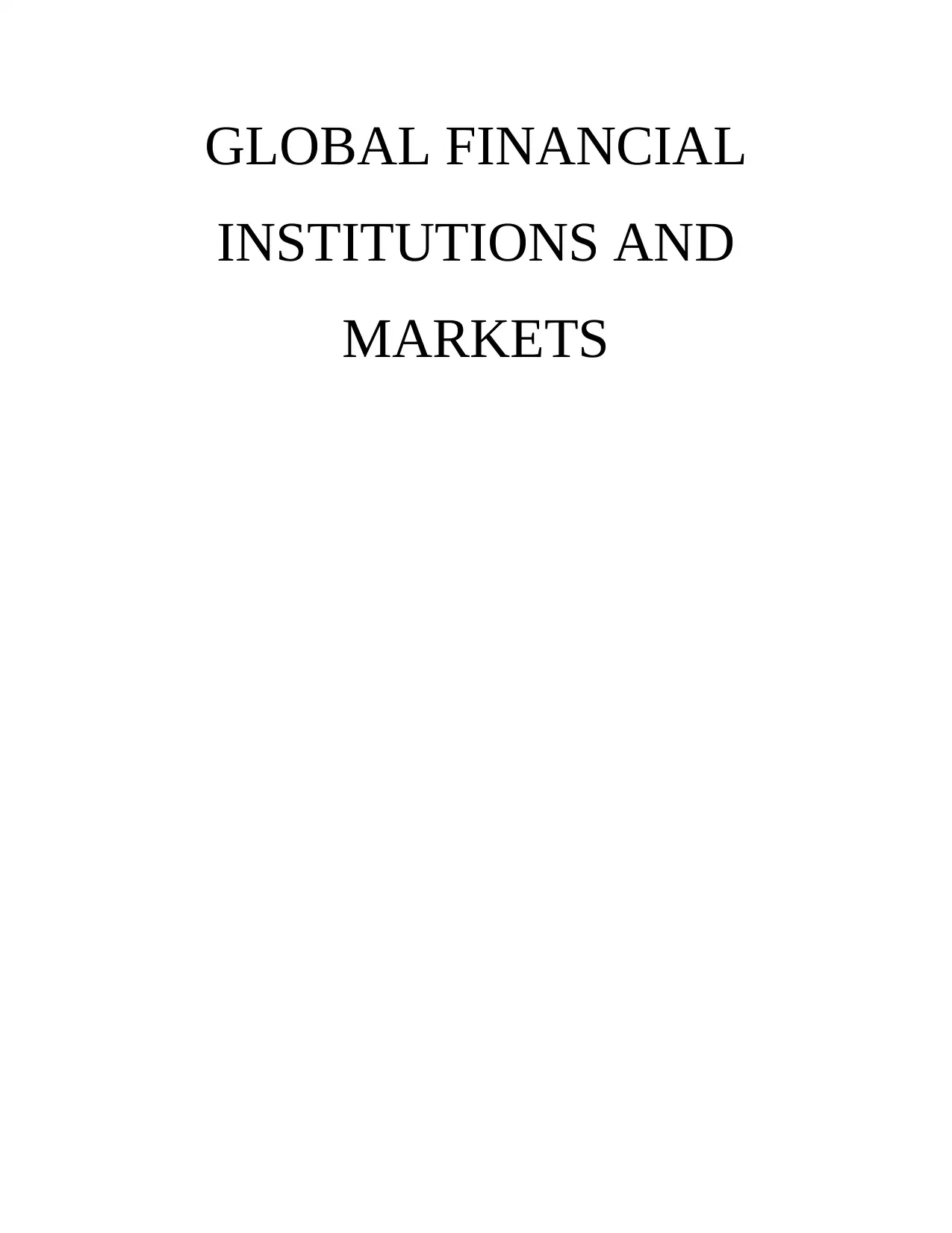
GLOBAL FINANCIAL
INSTITUTIONS AND
MARKETS
INSTITUTIONS AND
MARKETS
Paraphrase This Document
Need a fresh take? Get an instant paraphrase of this document with our AI Paraphraser
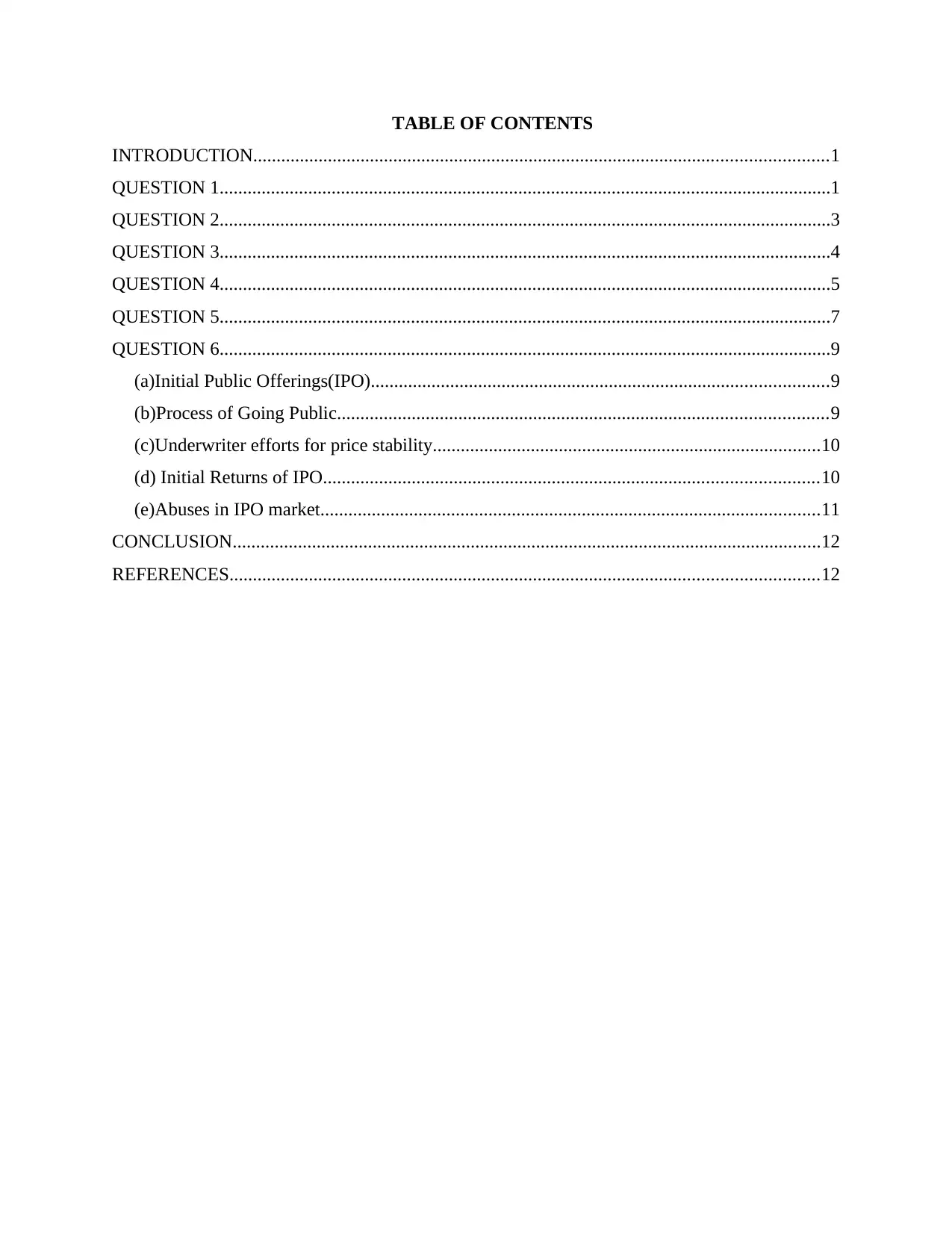
TABLE OF CONTENTS
INTRODUCTION...........................................................................................................................1
QUESTION 1...................................................................................................................................1
QUESTION 2...................................................................................................................................3
QUESTION 3...................................................................................................................................4
QUESTION 4...................................................................................................................................5
QUESTION 5...................................................................................................................................7
QUESTION 6...................................................................................................................................9
(a)Initial Public Offerings(IPO)..................................................................................................9
(b)Process of Going Public.........................................................................................................9
(c)Underwriter efforts for price stability...................................................................................10
(d) Initial Returns of IPO..........................................................................................................10
(e)Abuses in IPO market...........................................................................................................11
CONCLUSION..............................................................................................................................12
REFERENCES..............................................................................................................................12
INTRODUCTION...........................................................................................................................1
QUESTION 1...................................................................................................................................1
QUESTION 2...................................................................................................................................3
QUESTION 3...................................................................................................................................4
QUESTION 4...................................................................................................................................5
QUESTION 5...................................................................................................................................7
QUESTION 6...................................................................................................................................9
(a)Initial Public Offerings(IPO)..................................................................................................9
(b)Process of Going Public.........................................................................................................9
(c)Underwriter efforts for price stability...................................................................................10
(d) Initial Returns of IPO..........................................................................................................10
(e)Abuses in IPO market...........................................................................................................11
CONCLUSION..............................................................................................................................12
REFERENCES..............................................................................................................................12
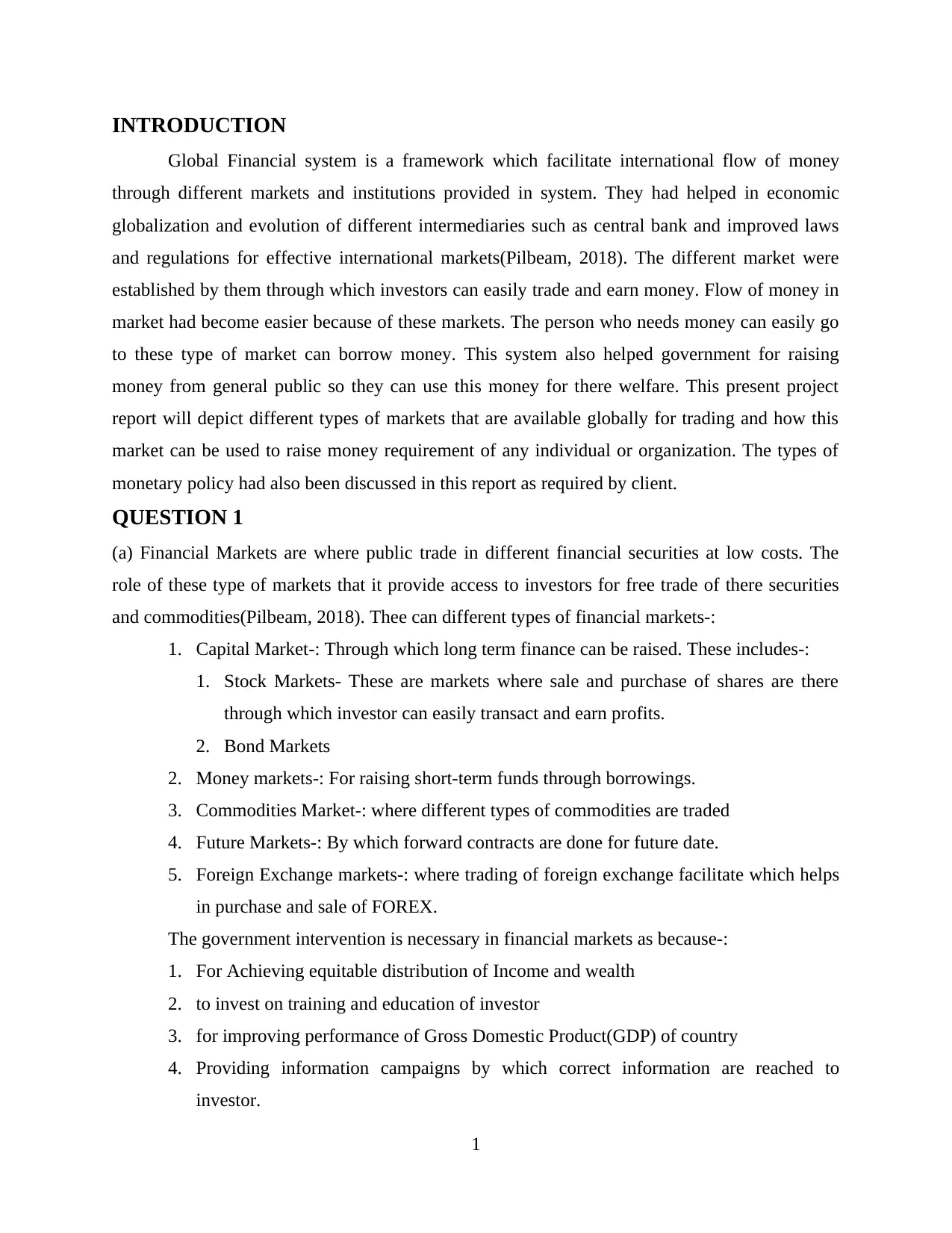
INTRODUCTION
Global Financial system is a framework which facilitate international flow of money
through different markets and institutions provided in system. They had helped in economic
globalization and evolution of different intermediaries such as central bank and improved laws
and regulations for effective international markets(Pilbeam, 2018). The different market were
established by them through which investors can easily trade and earn money. Flow of money in
market had become easier because of these markets. The person who needs money can easily go
to these type of market can borrow money. This system also helped government for raising
money from general public so they can use this money for there welfare. This present project
report will depict different types of markets that are available globally for trading and how this
market can be used to raise money requirement of any individual or organization. The types of
monetary policy had also been discussed in this report as required by client.
QUESTION 1
(a) Financial Markets are where public trade in different financial securities at low costs. The
role of these type of markets that it provide access to investors for free trade of there securities
and commodities(Pilbeam, 2018). Thee can different types of financial markets-:
1. Capital Market-: Through which long term finance can be raised. These includes-:
1. Stock Markets- These are markets where sale and purchase of shares are there
through which investor can easily transact and earn profits.
2. Bond Markets
2. Money markets-: For raising short-term funds through borrowings.
3. Commodities Market-: where different types of commodities are traded
4. Future Markets-: By which forward contracts are done for future date.
5. Foreign Exchange markets-: where trading of foreign exchange facilitate which helps
in purchase and sale of FOREX.
The government intervention is necessary in financial markets as because-:
1. For Achieving equitable distribution of Income and wealth
2. to invest on training and education of investor
3. for improving performance of Gross Domestic Product(GDP) of country
4. Providing information campaigns by which correct information are reached to
investor.
1
Global Financial system is a framework which facilitate international flow of money
through different markets and institutions provided in system. They had helped in economic
globalization and evolution of different intermediaries such as central bank and improved laws
and regulations for effective international markets(Pilbeam, 2018). The different market were
established by them through which investors can easily trade and earn money. Flow of money in
market had become easier because of these markets. The person who needs money can easily go
to these type of market can borrow money. This system also helped government for raising
money from general public so they can use this money for there welfare. This present project
report will depict different types of markets that are available globally for trading and how this
market can be used to raise money requirement of any individual or organization. The types of
monetary policy had also been discussed in this report as required by client.
QUESTION 1
(a) Financial Markets are where public trade in different financial securities at low costs. The
role of these type of markets that it provide access to investors for free trade of there securities
and commodities(Pilbeam, 2018). Thee can different types of financial markets-:
1. Capital Market-: Through which long term finance can be raised. These includes-:
1. Stock Markets- These are markets where sale and purchase of shares are there
through which investor can easily transact and earn profits.
2. Bond Markets
2. Money markets-: For raising short-term funds through borrowings.
3. Commodities Market-: where different types of commodities are traded
4. Future Markets-: By which forward contracts are done for future date.
5. Foreign Exchange markets-: where trading of foreign exchange facilitate which helps
in purchase and sale of FOREX.
The government intervention is necessary in financial markets as because-:
1. For Achieving equitable distribution of Income and wealth
2. to invest on training and education of investor
3. for improving performance of Gross Domestic Product(GDP) of country
4. Providing information campaigns by which correct information are reached to
investor.
1
⊘ This is a preview!⊘
Do you want full access?
Subscribe today to unlock all pages.

Trusted by 1+ million students worldwide
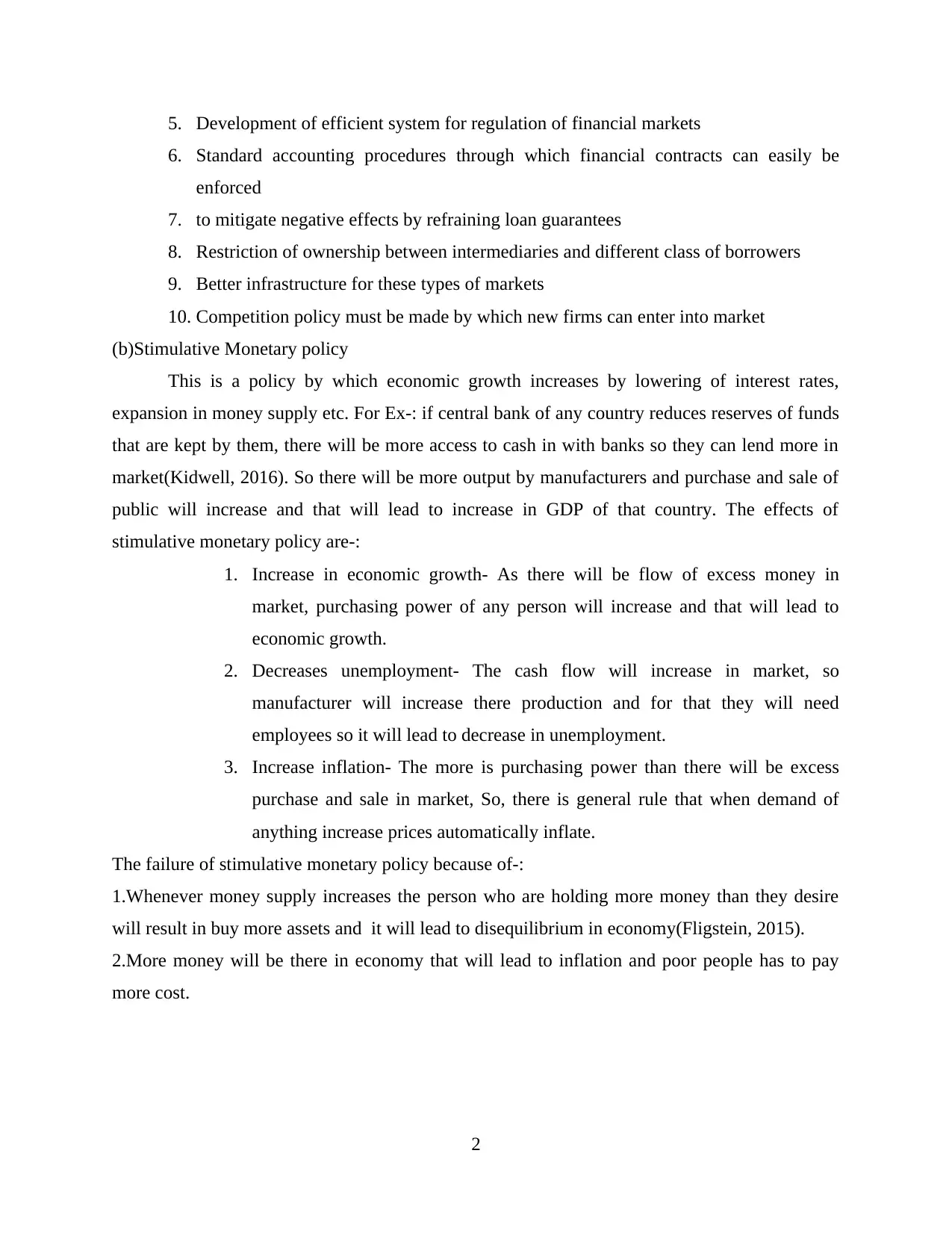
5. Development of efficient system for regulation of financial markets
6. Standard accounting procedures through which financial contracts can easily be
enforced
7. to mitigate negative effects by refraining loan guarantees
8. Restriction of ownership between intermediaries and different class of borrowers
9. Better infrastructure for these types of markets
10. Competition policy must be made by which new firms can enter into market
(b)Stimulative Monetary policy
This is a policy by which economic growth increases by lowering of interest rates,
expansion in money supply etc. For Ex-: if central bank of any country reduces reserves of funds
that are kept by them, there will be more access to cash in with banks so they can lend more in
market(Kidwell, 2016). So there will be more output by manufacturers and purchase and sale of
public will increase and that will lead to increase in GDP of that country. The effects of
stimulative monetary policy are-:
1. Increase in economic growth- As there will be flow of excess money in
market, purchasing power of any person will increase and that will lead to
economic growth.
2. Decreases unemployment- The cash flow will increase in market, so
manufacturer will increase there production and for that they will need
employees so it will lead to decrease in unemployment.
3. Increase inflation- The more is purchasing power than there will be excess
purchase and sale in market, So, there is general rule that when demand of
anything increase prices automatically inflate.
The failure of stimulative monetary policy because of-:
1.Whenever money supply increases the person who are holding more money than they desire
will result in buy more assets and it will lead to disequilibrium in economy(Fligstein, 2015).
2.More money will be there in economy that will lead to inflation and poor people has to pay
more cost.
2
6. Standard accounting procedures through which financial contracts can easily be
enforced
7. to mitigate negative effects by refraining loan guarantees
8. Restriction of ownership between intermediaries and different class of borrowers
9. Better infrastructure for these types of markets
10. Competition policy must be made by which new firms can enter into market
(b)Stimulative Monetary policy
This is a policy by which economic growth increases by lowering of interest rates,
expansion in money supply etc. For Ex-: if central bank of any country reduces reserves of funds
that are kept by them, there will be more access to cash in with banks so they can lend more in
market(Kidwell, 2016). So there will be more output by manufacturers and purchase and sale of
public will increase and that will lead to increase in GDP of that country. The effects of
stimulative monetary policy are-:
1. Increase in economic growth- As there will be flow of excess money in
market, purchasing power of any person will increase and that will lead to
economic growth.
2. Decreases unemployment- The cash flow will increase in market, so
manufacturer will increase there production and for that they will need
employees so it will lead to decrease in unemployment.
3. Increase inflation- The more is purchasing power than there will be excess
purchase and sale in market, So, there is general rule that when demand of
anything increase prices automatically inflate.
The failure of stimulative monetary policy because of-:
1.Whenever money supply increases the person who are holding more money than they desire
will result in buy more assets and it will lead to disequilibrium in economy(Fligstein, 2015).
2.More money will be there in economy that will lead to inflation and poor people has to pay
more cost.
2
Paraphrase This Document
Need a fresh take? Get an instant paraphrase of this document with our AI Paraphraser
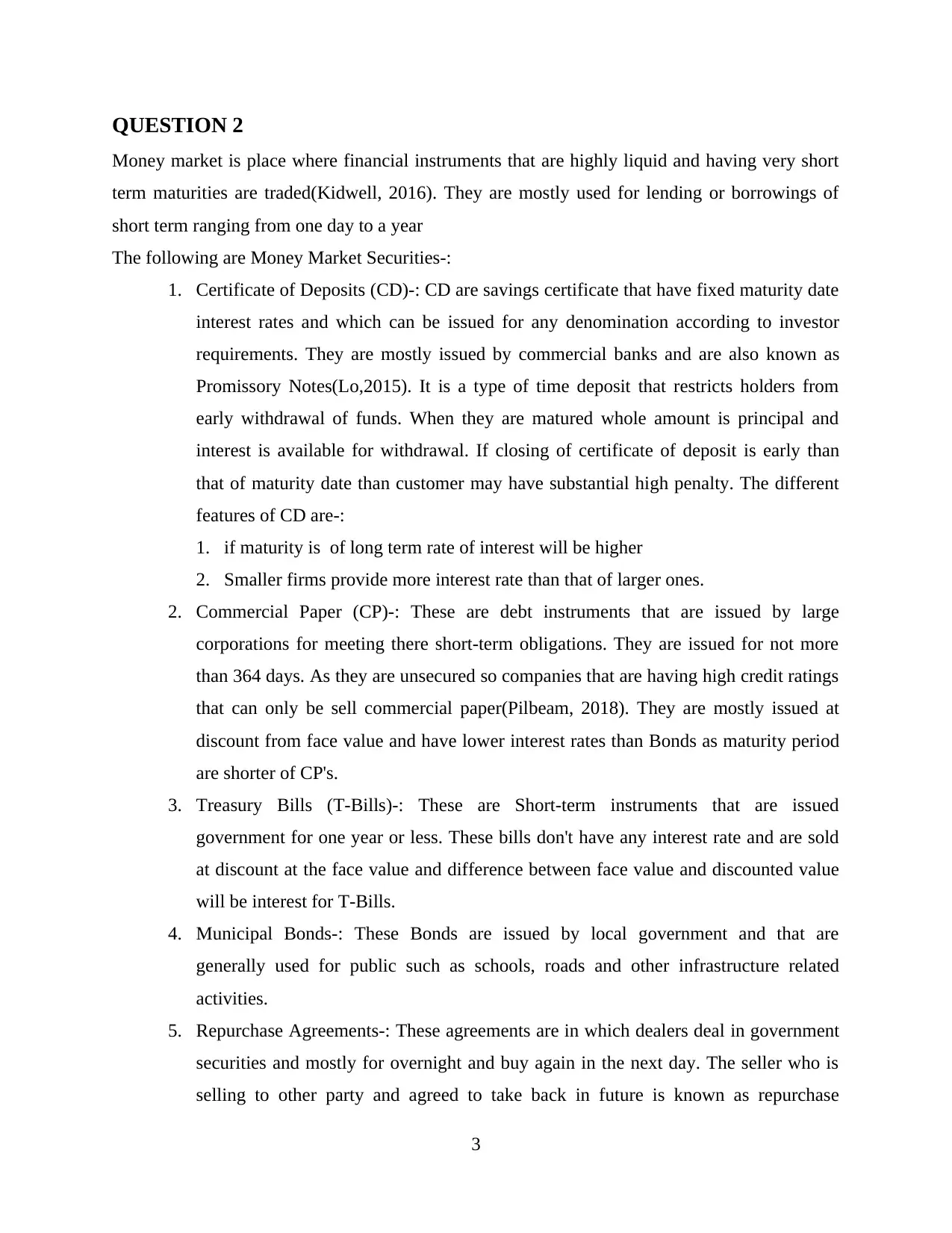
QUESTION 2
Money market is place where financial instruments that are highly liquid and having very short
term maturities are traded(Kidwell, 2016). They are mostly used for lending or borrowings of
short term ranging from one day to a year
The following are Money Market Securities-:
1. Certificate of Deposits (CD)-: CD are savings certificate that have fixed maturity date
interest rates and which can be issued for any denomination according to investor
requirements. They are mostly issued by commercial banks and are also known as
Promissory Notes(Lo,2015). It is a type of time deposit that restricts holders from
early withdrawal of funds. When they are matured whole amount is principal and
interest is available for withdrawal. If closing of certificate of deposit is early than
that of maturity date than customer may have substantial high penalty. The different
features of CD are-:
1. if maturity is of long term rate of interest will be higher
2. Smaller firms provide more interest rate than that of larger ones.
2. Commercial Paper (CP)-: These are debt instruments that are issued by large
corporations for meeting there short-term obligations. They are issued for not more
than 364 days. As they are unsecured so companies that are having high credit ratings
that can only be sell commercial paper(Pilbeam, 2018). They are mostly issued at
discount from face value and have lower interest rates than Bonds as maturity period
are shorter of CP's.
3. Treasury Bills (T-Bills)-: These are Short-term instruments that are issued
government for one year or less. These bills don't have any interest rate and are sold
at discount at the face value and difference between face value and discounted value
will be interest for T-Bills.
4. Municipal Bonds-: These Bonds are issued by local government and that are
generally used for public such as schools, roads and other infrastructure related
activities.
5. Repurchase Agreements-: These agreements are in which dealers deal in government
securities and mostly for overnight and buy again in the next day. The seller who is
selling to other party and agreed to take back in future is known as repurchase
3
Money market is place where financial instruments that are highly liquid and having very short
term maturities are traded(Kidwell, 2016). They are mostly used for lending or borrowings of
short term ranging from one day to a year
The following are Money Market Securities-:
1. Certificate of Deposits (CD)-: CD are savings certificate that have fixed maturity date
interest rates and which can be issued for any denomination according to investor
requirements. They are mostly issued by commercial banks and are also known as
Promissory Notes(Lo,2015). It is a type of time deposit that restricts holders from
early withdrawal of funds. When they are matured whole amount is principal and
interest is available for withdrawal. If closing of certificate of deposit is early than
that of maturity date than customer may have substantial high penalty. The different
features of CD are-:
1. if maturity is of long term rate of interest will be higher
2. Smaller firms provide more interest rate than that of larger ones.
2. Commercial Paper (CP)-: These are debt instruments that are issued by large
corporations for meeting there short-term obligations. They are issued for not more
than 364 days. As they are unsecured so companies that are having high credit ratings
that can only be sell commercial paper(Pilbeam, 2018). They are mostly issued at
discount from face value and have lower interest rates than Bonds as maturity period
are shorter of CP's.
3. Treasury Bills (T-Bills)-: These are Short-term instruments that are issued
government for one year or less. These bills don't have any interest rate and are sold
at discount at the face value and difference between face value and discounted value
will be interest for T-Bills.
4. Municipal Bonds-: These Bonds are issued by local government and that are
generally used for public such as schools, roads and other infrastructure related
activities.
5. Repurchase Agreements-: These agreements are in which dealers deal in government
securities and mostly for overnight and buy again in the next day. The seller who is
selling to other party and agreed to take back in future is known as repurchase
3
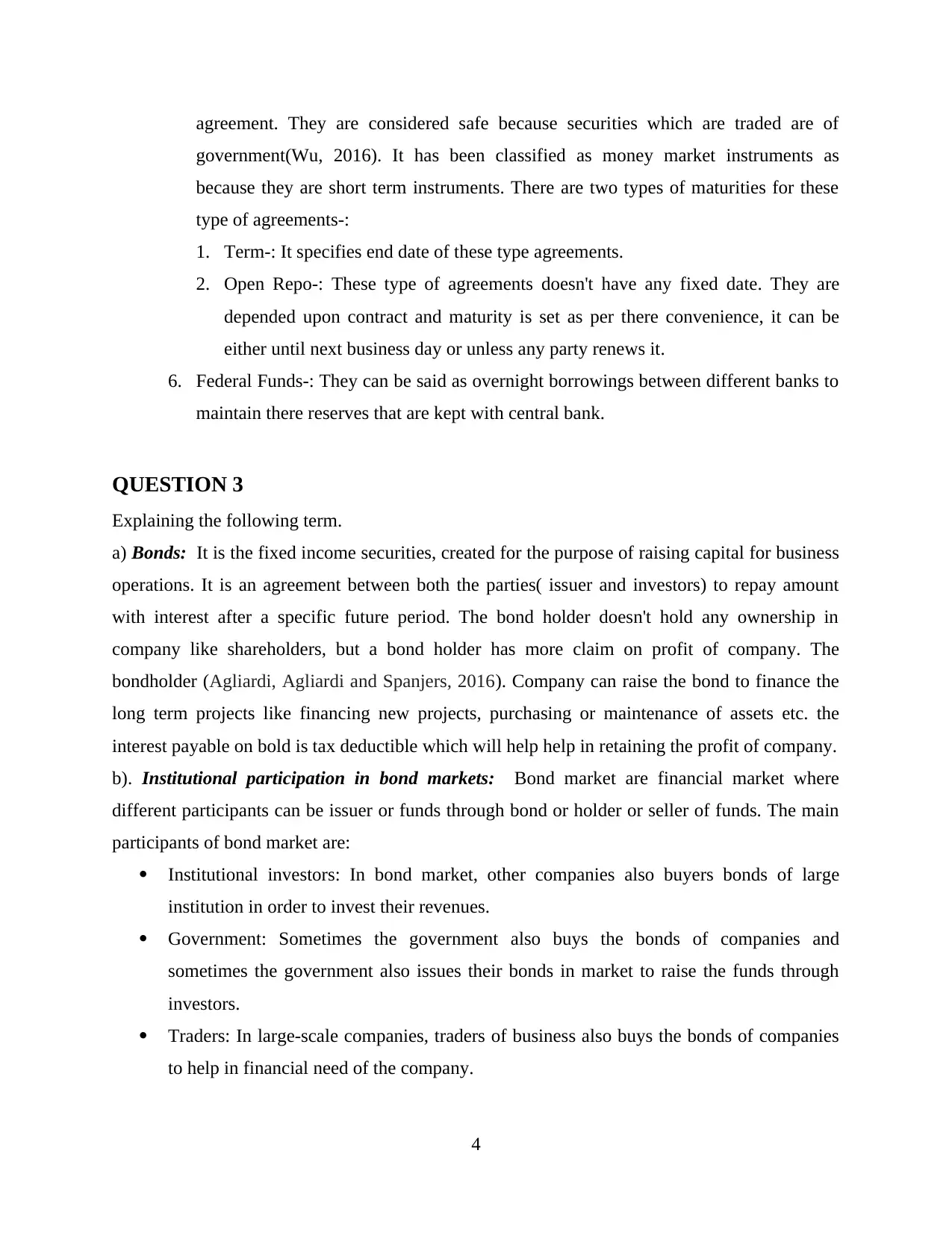
agreement. They are considered safe because securities which are traded are of
government(Wu, 2016). It has been classified as money market instruments as
because they are short term instruments. There are two types of maturities for these
type of agreements-:
1. Term-: It specifies end date of these type agreements.
2. Open Repo-: These type of agreements doesn't have any fixed date. They are
depended upon contract and maturity is set as per there convenience, it can be
either until next business day or unless any party renews it.
6. Federal Funds-: They can be said as overnight borrowings between different banks to
maintain there reserves that are kept with central bank.
QUESTION 3
Explaining the following term.
a) Bonds: It is the fixed income securities, created for the purpose of raising capital for business
operations. It is an agreement between both the parties( issuer and investors) to repay amount
with interest after a specific future period. The bond holder doesn't hold any ownership in
company like shareholders, but a bond holder has more claim on profit of company. The
bondholder (Agliardi, Agliardi and Spanjers, 2016). Company can raise the bond to finance the
long term projects like financing new projects, purchasing or maintenance of assets etc. the
interest payable on bold is tax deductible which will help help in retaining the profit of company.
b). Institutional participation in bond markets: Bond market are financial market where
different participants can be issuer or funds through bond or holder or seller of funds. The main
participants of bond market are:
Institutional investors: In bond market, other companies also buyers bonds of large
institution in order to invest their revenues.
Government: Sometimes the government also buys the bonds of companies and
sometimes the government also issues their bonds in market to raise the funds through
investors.
Traders: In large-scale companies, traders of business also buys the bonds of companies
to help in financial need of the company.
4
government(Wu, 2016). It has been classified as money market instruments as
because they are short term instruments. There are two types of maturities for these
type of agreements-:
1. Term-: It specifies end date of these type agreements.
2. Open Repo-: These type of agreements doesn't have any fixed date. They are
depended upon contract and maturity is set as per there convenience, it can be
either until next business day or unless any party renews it.
6. Federal Funds-: They can be said as overnight borrowings between different banks to
maintain there reserves that are kept with central bank.
QUESTION 3
Explaining the following term.
a) Bonds: It is the fixed income securities, created for the purpose of raising capital for business
operations. It is an agreement between both the parties( issuer and investors) to repay amount
with interest after a specific future period. The bond holder doesn't hold any ownership in
company like shareholders, but a bond holder has more claim on profit of company. The
bondholder (Agliardi, Agliardi and Spanjers, 2016). Company can raise the bond to finance the
long term projects like financing new projects, purchasing or maintenance of assets etc. the
interest payable on bold is tax deductible which will help help in retaining the profit of company.
b). Institutional participation in bond markets: Bond market are financial market where
different participants can be issuer or funds through bond or holder or seller of funds. The main
participants of bond market are:
Institutional investors: In bond market, other companies also buyers bonds of large
institution in order to invest their revenues.
Government: Sometimes the government also buys the bonds of companies and
sometimes the government also issues their bonds in market to raise the funds through
investors.
Traders: In large-scale companies, traders of business also buys the bonds of companies
to help in financial need of the company.
4
⊘ This is a preview!⊘
Do you want full access?
Subscribe today to unlock all pages.

Trusted by 1+ million students worldwide
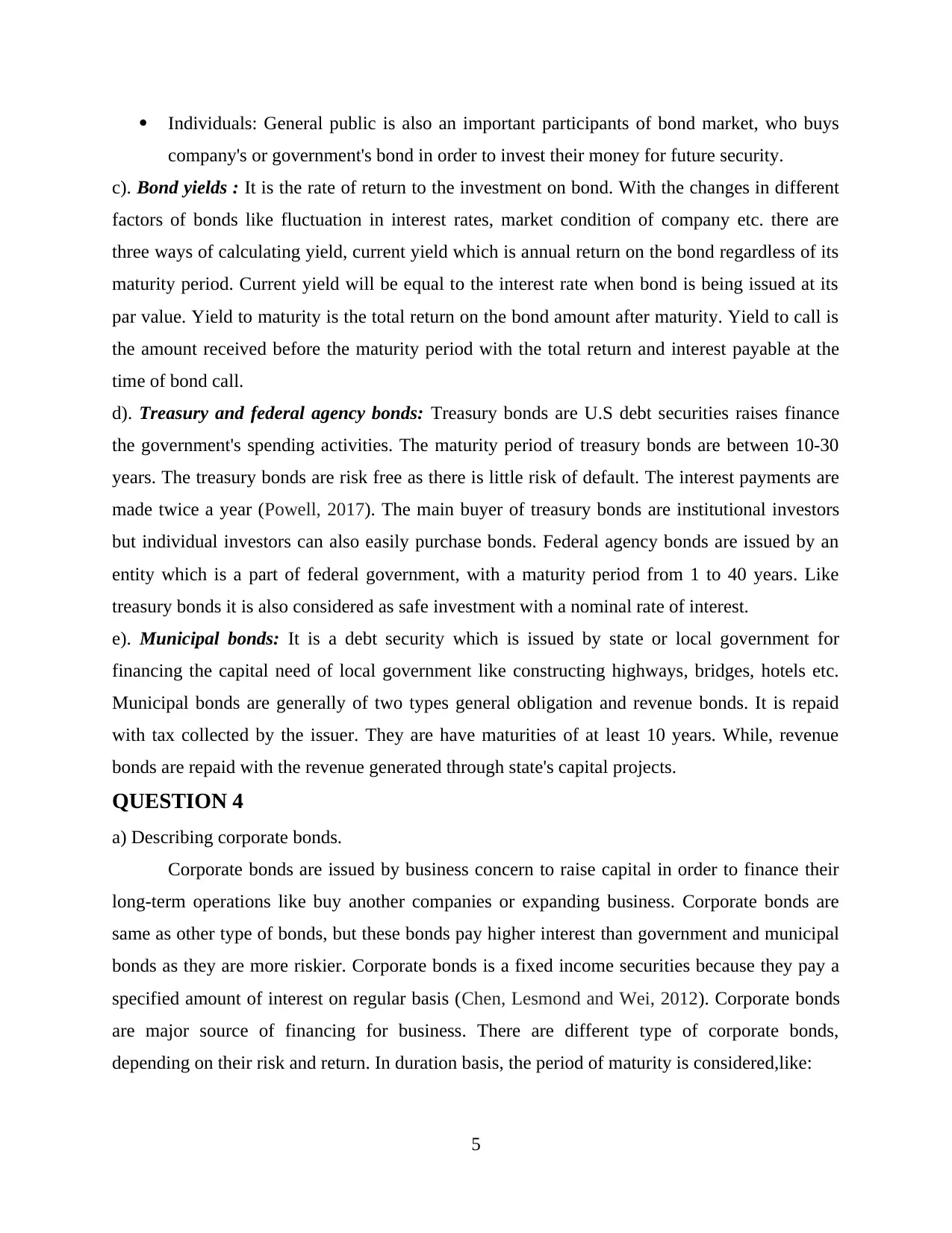
Individuals: General public is also an important participants of bond market, who buys
company's or government's bond in order to invest their money for future security.
c). Bond yields : It is the rate of return to the investment on bond. With the changes in different
factors of bonds like fluctuation in interest rates, market condition of company etc. there are
three ways of calculating yield, current yield which is annual return on the bond regardless of its
maturity period. Current yield will be equal to the interest rate when bond is being issued at its
par value. Yield to maturity is the total return on the bond amount after maturity. Yield to call is
the amount received before the maturity period with the total return and interest payable at the
time of bond call.
d). Treasury and federal agency bonds: Treasury bonds are U.S debt securities raises finance
the government's spending activities. The maturity period of treasury bonds are between 10-30
years. The treasury bonds are risk free as there is little risk of default. The interest payments are
made twice a year (Powell, 2017). The main buyer of treasury bonds are institutional investors
but individual investors can also easily purchase bonds. Federal agency bonds are issued by an
entity which is a part of federal government, with a maturity period from 1 to 40 years. Like
treasury bonds it is also considered as safe investment with a nominal rate of interest.
e). Municipal bonds: It is a debt security which is issued by state or local government for
financing the capital need of local government like constructing highways, bridges, hotels etc.
Municipal bonds are generally of two types general obligation and revenue bonds. It is repaid
with tax collected by the issuer. They are have maturities of at least 10 years. While, revenue
bonds are repaid with the revenue generated through state's capital projects.
QUESTION 4
a) Describing corporate bonds.
Corporate bonds are issued by business concern to raise capital in order to finance their
long-term operations like buy another companies or expanding business. Corporate bonds are
same as other type of bonds, but these bonds pay higher interest than government and municipal
bonds as they are more riskier. Corporate bonds is a fixed income securities because they pay a
specified amount of interest on regular basis (Chen, Lesmond and Wei, 2012). Corporate bonds
are major source of financing for business. There are different type of corporate bonds,
depending on their risk and return. In duration basis, the period of maturity is considered,like:
5
company's or government's bond in order to invest their money for future security.
c). Bond yields : It is the rate of return to the investment on bond. With the changes in different
factors of bonds like fluctuation in interest rates, market condition of company etc. there are
three ways of calculating yield, current yield which is annual return on the bond regardless of its
maturity period. Current yield will be equal to the interest rate when bond is being issued at its
par value. Yield to maturity is the total return on the bond amount after maturity. Yield to call is
the amount received before the maturity period with the total return and interest payable at the
time of bond call.
d). Treasury and federal agency bonds: Treasury bonds are U.S debt securities raises finance
the government's spending activities. The maturity period of treasury bonds are between 10-30
years. The treasury bonds are risk free as there is little risk of default. The interest payments are
made twice a year (Powell, 2017). The main buyer of treasury bonds are institutional investors
but individual investors can also easily purchase bonds. Federal agency bonds are issued by an
entity which is a part of federal government, with a maturity period from 1 to 40 years. Like
treasury bonds it is also considered as safe investment with a nominal rate of interest.
e). Municipal bonds: It is a debt security which is issued by state or local government for
financing the capital need of local government like constructing highways, bridges, hotels etc.
Municipal bonds are generally of two types general obligation and revenue bonds. It is repaid
with tax collected by the issuer. They are have maturities of at least 10 years. While, revenue
bonds are repaid with the revenue generated through state's capital projects.
QUESTION 4
a) Describing corporate bonds.
Corporate bonds are issued by business concern to raise capital in order to finance their
long-term operations like buy another companies or expanding business. Corporate bonds are
same as other type of bonds, but these bonds pay higher interest than government and municipal
bonds as they are more riskier. Corporate bonds is a fixed income securities because they pay a
specified amount of interest on regular basis (Chen, Lesmond and Wei, 2012). Corporate bonds
are major source of financing for business. There are different type of corporate bonds,
depending on their risk and return. In duration basis, the period of maturity is considered,like:
5
Paraphrase This Document
Need a fresh take? Get an instant paraphrase of this document with our AI Paraphraser
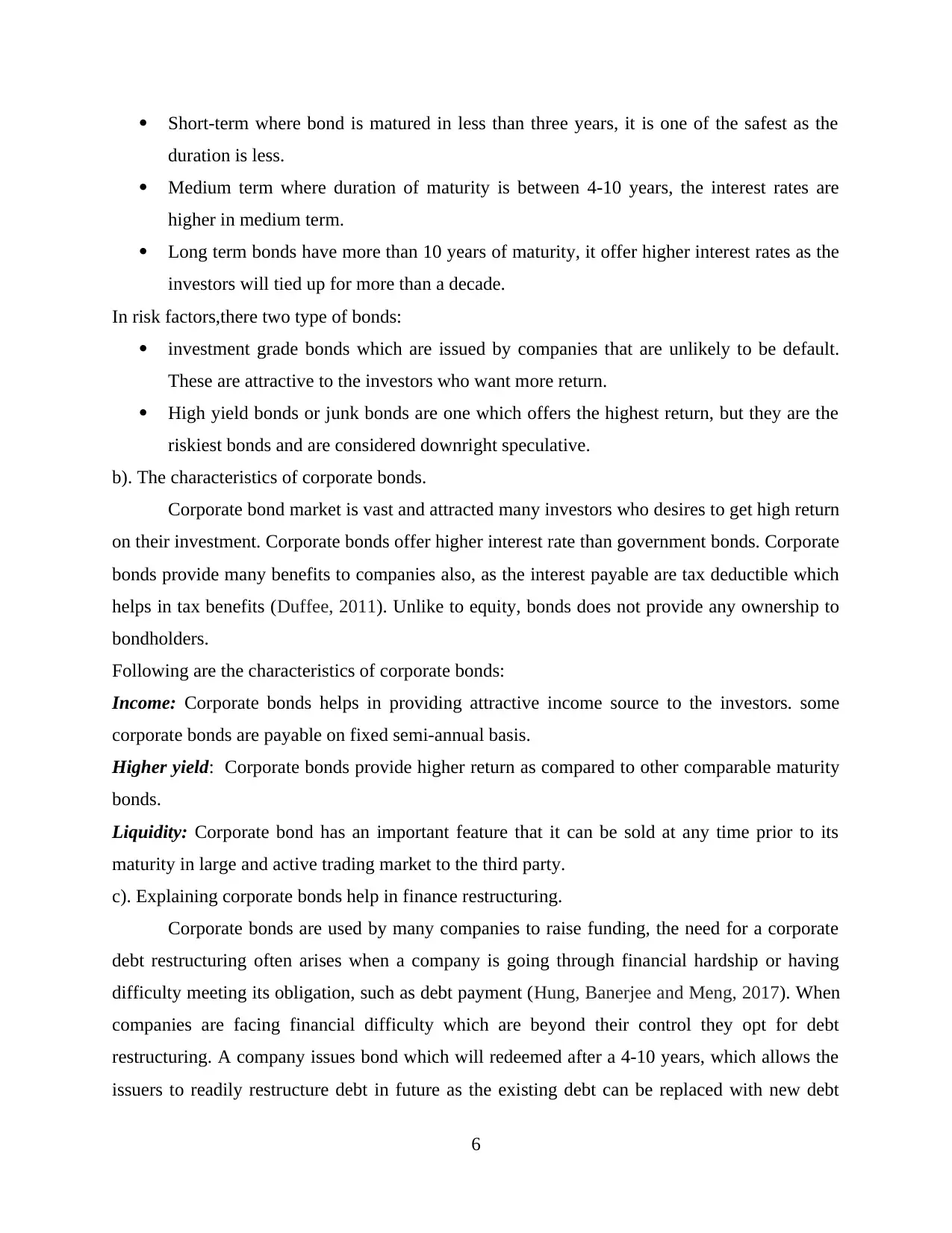
Short-term where bond is matured in less than three years, it is one of the safest as the
duration is less.
Medium term where duration of maturity is between 4-10 years, the interest rates are
higher in medium term.
Long term bonds have more than 10 years of maturity, it offer higher interest rates as the
investors will tied up for more than a decade.
In risk factors,there two type of bonds:
investment grade bonds which are issued by companies that are unlikely to be default.
These are attractive to the investors who want more return.
High yield bonds or junk bonds are one which offers the highest return, but they are the
riskiest bonds and are considered downright speculative.
b). The characteristics of corporate bonds.
Corporate bond market is vast and attracted many investors who desires to get high return
on their investment. Corporate bonds offer higher interest rate than government bonds. Corporate
bonds provide many benefits to companies also, as the interest payable are tax deductible which
helps in tax benefits (Duffee, 2011). Unlike to equity, bonds does not provide any ownership to
bondholders.
Following are the characteristics of corporate bonds:
Income: Corporate bonds helps in providing attractive income source to the investors. some
corporate bonds are payable on fixed semi-annual basis.
Higher yield: Corporate bonds provide higher return as compared to other comparable maturity
bonds.
Liquidity: Corporate bond has an important feature that it can be sold at any time prior to its
maturity in large and active trading market to the third party.
c). Explaining corporate bonds help in finance restructuring.
Corporate bonds are used by many companies to raise funding, the need for a corporate
debt restructuring often arises when a company is going through financial hardship or having
difficulty meeting its obligation, such as debt payment (Hung, Banerjee and Meng, 2017). When
companies are facing financial difficulty which are beyond their control they opt for debt
restructuring. A company issues bond which will redeemed after a 4-10 years, which allows the
issuers to readily restructure debt in future as the existing debt can be replaced with new debt
6
duration is less.
Medium term where duration of maturity is between 4-10 years, the interest rates are
higher in medium term.
Long term bonds have more than 10 years of maturity, it offer higher interest rates as the
investors will tied up for more than a decade.
In risk factors,there two type of bonds:
investment grade bonds which are issued by companies that are unlikely to be default.
These are attractive to the investors who want more return.
High yield bonds or junk bonds are one which offers the highest return, but they are the
riskiest bonds and are considered downright speculative.
b). The characteristics of corporate bonds.
Corporate bond market is vast and attracted many investors who desires to get high return
on their investment. Corporate bonds offer higher interest rate than government bonds. Corporate
bonds provide many benefits to companies also, as the interest payable are tax deductible which
helps in tax benefits (Duffee, 2011). Unlike to equity, bonds does not provide any ownership to
bondholders.
Following are the characteristics of corporate bonds:
Income: Corporate bonds helps in providing attractive income source to the investors. some
corporate bonds are payable on fixed semi-annual basis.
Higher yield: Corporate bonds provide higher return as compared to other comparable maturity
bonds.
Liquidity: Corporate bond has an important feature that it can be sold at any time prior to its
maturity in large and active trading market to the third party.
c). Explaining corporate bonds help in finance restructuring.
Corporate bonds are used by many companies to raise funding, the need for a corporate
debt restructuring often arises when a company is going through financial hardship or having
difficulty meeting its obligation, such as debt payment (Hung, Banerjee and Meng, 2017). When
companies are facing financial difficulty which are beyond their control they opt for debt
restructuring. A company issues bond which will redeemed after a 4-10 years, which allows the
issuers to readily restructure debt in future as the existing debt can be replaced with new debt
6
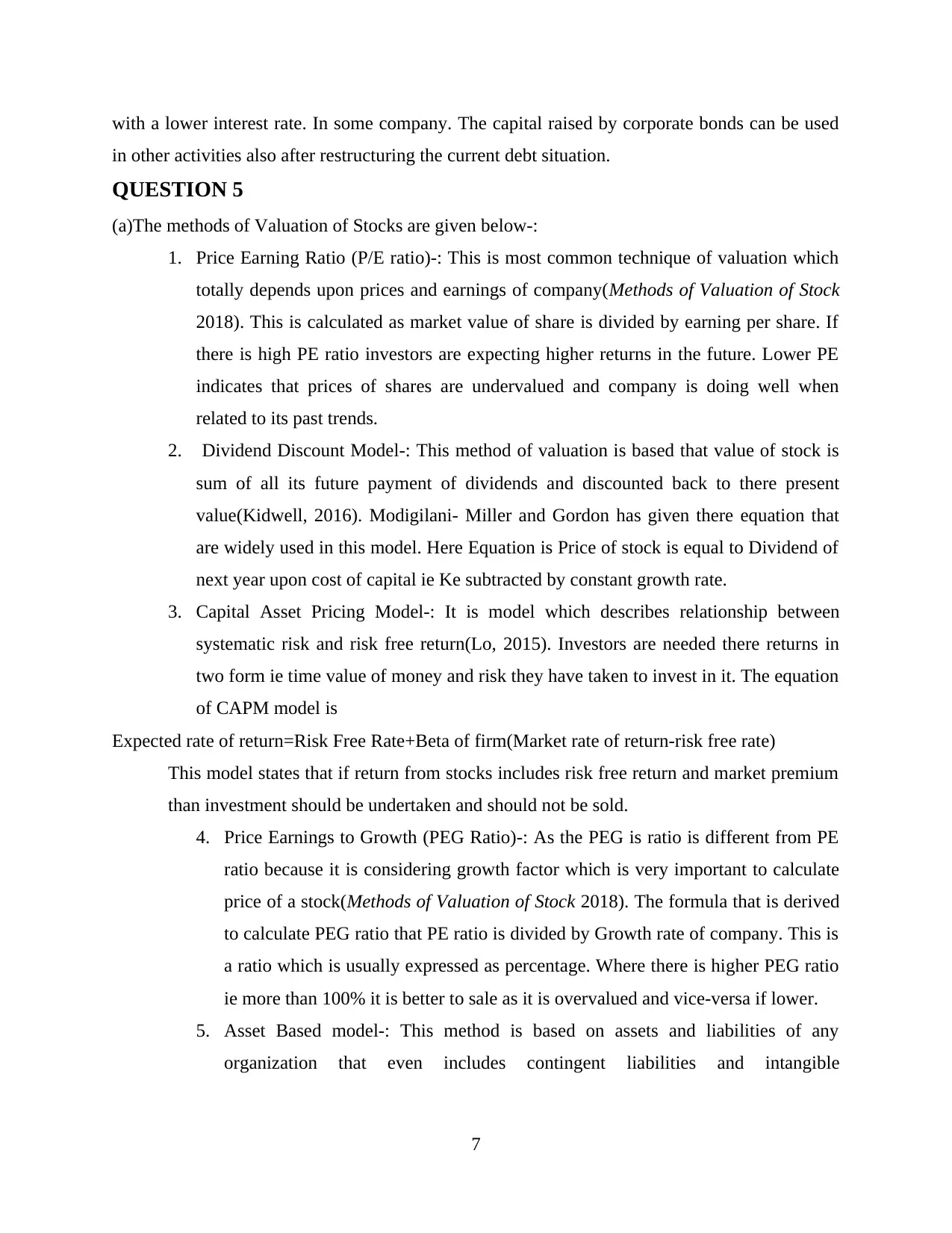
with a lower interest rate. In some company. The capital raised by corporate bonds can be used
in other activities also after restructuring the current debt situation.
QUESTION 5
(a)The methods of Valuation of Stocks are given below-:
1. Price Earning Ratio (P/E ratio)-: This is most common technique of valuation which
totally depends upon prices and earnings of company(Methods of Valuation of Stock
2018). This is calculated as market value of share is divided by earning per share. If
there is high PE ratio investors are expecting higher returns in the future. Lower PE
indicates that prices of shares are undervalued and company is doing well when
related to its past trends.
2. Dividend Discount Model-: This method of valuation is based that value of stock is
sum of all its future payment of dividends and discounted back to there present
value(Kidwell, 2016). Modigilani- Miller and Gordon has given there equation that
are widely used in this model. Here Equation is Price of stock is equal to Dividend of
next year upon cost of capital ie Ke subtracted by constant growth rate.
3. Capital Asset Pricing Model-: It is model which describes relationship between
systematic risk and risk free return(Lo, 2015). Investors are needed there returns in
two form ie time value of money and risk they have taken to invest in it. The equation
of CAPM model is
Expected rate of return=Risk Free Rate+Beta of firm(Market rate of return-risk free rate)
This model states that if return from stocks includes risk free return and market premium
than investment should be undertaken and should not be sold.
4. Price Earnings to Growth (PEG Ratio)-: As the PEG is ratio is different from PE
ratio because it is considering growth factor which is very important to calculate
price of a stock(Methods of Valuation of Stock 2018). The formula that is derived
to calculate PEG ratio that PE ratio is divided by Growth rate of company. This is
a ratio which is usually expressed as percentage. Where there is higher PEG ratio
ie more than 100% it is better to sale as it is overvalued and vice-versa if lower.
5. Asset Based model-: This method is based on assets and liabilities of any
organization that even includes contingent liabilities and intangible
7
in other activities also after restructuring the current debt situation.
QUESTION 5
(a)The methods of Valuation of Stocks are given below-:
1. Price Earning Ratio (P/E ratio)-: This is most common technique of valuation which
totally depends upon prices and earnings of company(Methods of Valuation of Stock
2018). This is calculated as market value of share is divided by earning per share. If
there is high PE ratio investors are expecting higher returns in the future. Lower PE
indicates that prices of shares are undervalued and company is doing well when
related to its past trends.
2. Dividend Discount Model-: This method of valuation is based that value of stock is
sum of all its future payment of dividends and discounted back to there present
value(Kidwell, 2016). Modigilani- Miller and Gordon has given there equation that
are widely used in this model. Here Equation is Price of stock is equal to Dividend of
next year upon cost of capital ie Ke subtracted by constant growth rate.
3. Capital Asset Pricing Model-: It is model which describes relationship between
systematic risk and risk free return(Lo, 2015). Investors are needed there returns in
two form ie time value of money and risk they have taken to invest in it. The equation
of CAPM model is
Expected rate of return=Risk Free Rate+Beta of firm(Market rate of return-risk free rate)
This model states that if return from stocks includes risk free return and market premium
than investment should be undertaken and should not be sold.
4. Price Earnings to Growth (PEG Ratio)-: As the PEG is ratio is different from PE
ratio because it is considering growth factor which is very important to calculate
price of a stock(Methods of Valuation of Stock 2018). The formula that is derived
to calculate PEG ratio that PE ratio is divided by Growth rate of company. This is
a ratio which is usually expressed as percentage. Where there is higher PEG ratio
ie more than 100% it is better to sale as it is overvalued and vice-versa if lower.
5. Asset Based model-: This method is based on assets and liabilities of any
organization that even includes contingent liabilities and intangible
7
⊘ This is a preview!⊘
Do you want full access?
Subscribe today to unlock all pages.

Trusted by 1+ million students worldwide
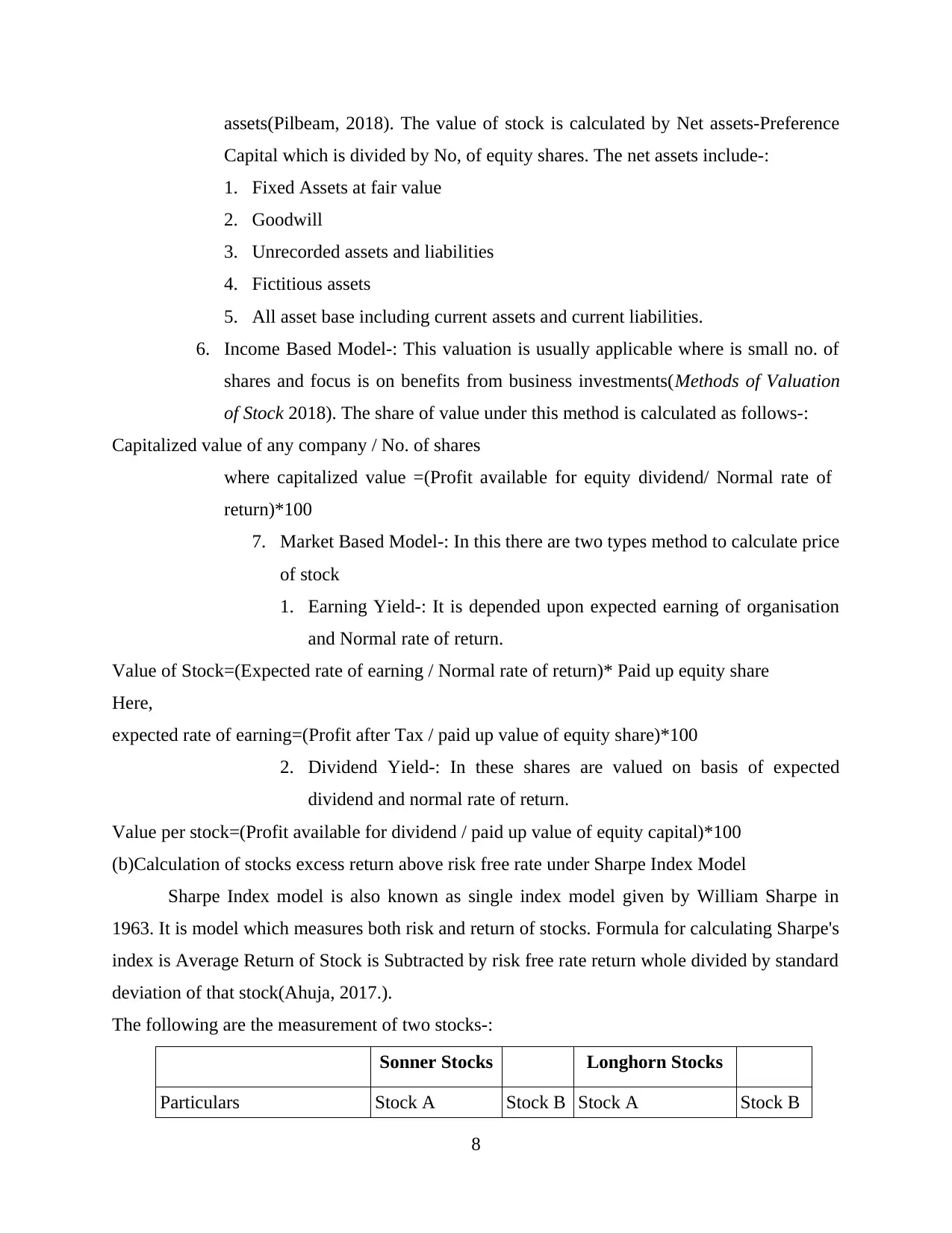
assets(Pilbeam, 2018). The value of stock is calculated by Net assets-Preference
Capital which is divided by No, of equity shares. The net assets include-:
1. Fixed Assets at fair value
2. Goodwill
3. Unrecorded assets and liabilities
4. Fictitious assets
5. All asset base including current assets and current liabilities.
6. Income Based Model-: This valuation is usually applicable where is small no. of
shares and focus is on benefits from business investments(Methods of Valuation
of Stock 2018). The share of value under this method is calculated as follows-:
Capitalized value of any company / No. of shares
where capitalized value =(Profit available for equity dividend/ Normal rate of
return)*100
7. Market Based Model-: In this there are two types method to calculate price
of stock
1. Earning Yield-: It is depended upon expected earning of organisation
and Normal rate of return.
Value of Stock=(Expected rate of earning / Normal rate of return)* Paid up equity share
Here,
expected rate of earning=(Profit after Tax / paid up value of equity share)*100
2. Dividend Yield-: In these shares are valued on basis of expected
dividend and normal rate of return.
Value per stock=(Profit available for dividend / paid up value of equity capital)*100
(b)Calculation of stocks excess return above risk free rate under Sharpe Index Model
Sharpe Index model is also known as single index model given by William Sharpe in
1963. It is model which measures both risk and return of stocks. Formula for calculating Sharpe's
index is Average Return of Stock is Subtracted by risk free rate return whole divided by standard
deviation of that stock(Ahuja, 2017.).
The following are the measurement of two stocks-:
Sonner Stocks Longhorn Stocks
Particulars Stock A Stock B Stock A Stock B
8
Capital which is divided by No, of equity shares. The net assets include-:
1. Fixed Assets at fair value
2. Goodwill
3. Unrecorded assets and liabilities
4. Fictitious assets
5. All asset base including current assets and current liabilities.
6. Income Based Model-: This valuation is usually applicable where is small no. of
shares and focus is on benefits from business investments(Methods of Valuation
of Stock 2018). The share of value under this method is calculated as follows-:
Capitalized value of any company / No. of shares
where capitalized value =(Profit available for equity dividend/ Normal rate of
return)*100
7. Market Based Model-: In this there are two types method to calculate price
of stock
1. Earning Yield-: It is depended upon expected earning of organisation
and Normal rate of return.
Value of Stock=(Expected rate of earning / Normal rate of return)* Paid up equity share
Here,
expected rate of earning=(Profit after Tax / paid up value of equity share)*100
2. Dividend Yield-: In these shares are valued on basis of expected
dividend and normal rate of return.
Value per stock=(Profit available for dividend / paid up value of equity capital)*100
(b)Calculation of stocks excess return above risk free rate under Sharpe Index Model
Sharpe Index model is also known as single index model given by William Sharpe in
1963. It is model which measures both risk and return of stocks. Formula for calculating Sharpe's
index is Average Return of Stock is Subtracted by risk free rate return whole divided by standard
deviation of that stock(Ahuja, 2017.).
The following are the measurement of two stocks-:
Sonner Stocks Longhorn Stocks
Particulars Stock A Stock B Stock A Stock B
8
Paraphrase This Document
Need a fresh take? Get an instant paraphrase of this document with our AI Paraphraser
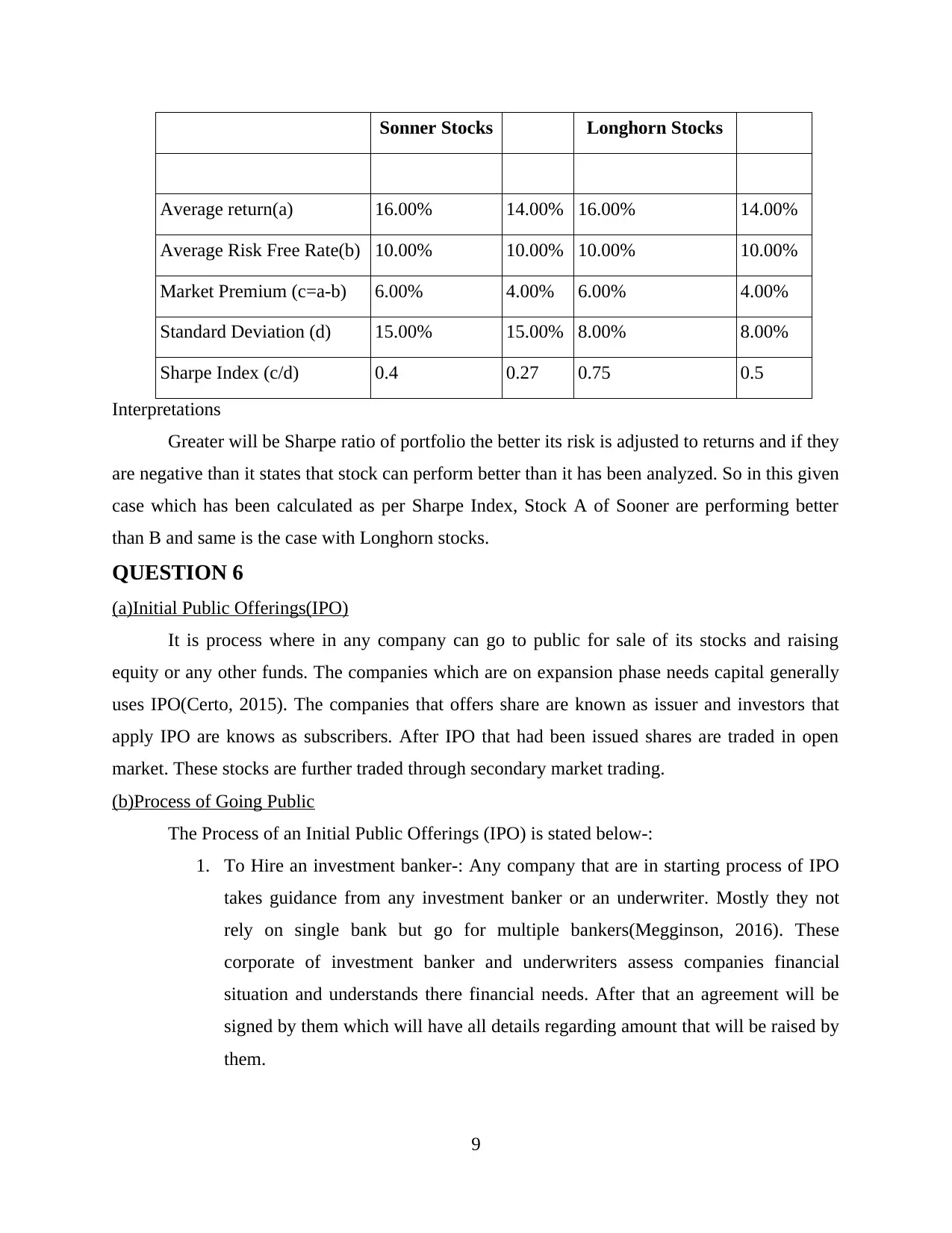
Sonner Stocks Longhorn Stocks
Average return(a) 16.00% 14.00% 16.00% 14.00%
Average Risk Free Rate(b) 10.00% 10.00% 10.00% 10.00%
Market Premium (c=a-b) 6.00% 4.00% 6.00% 4.00%
Standard Deviation (d) 15.00% 15.00% 8.00% 8.00%
Sharpe Index (c/d) 0.4 0.27 0.75 0.5
Interpretations
Greater will be Sharpe ratio of portfolio the better its risk is adjusted to returns and if they
are negative than it states that stock can perform better than it has been analyzed. So in this given
case which has been calculated as per Sharpe Index, Stock A of Sooner are performing better
than B and same is the case with Longhorn stocks.
QUESTION 6
(a)Initial Public Offerings(IPO)
It is process where in any company can go to public for sale of its stocks and raising
equity or any other funds. The companies which are on expansion phase needs capital generally
uses IPO(Certo, 2015). The companies that offers share are known as issuer and investors that
apply IPO are knows as subscribers. After IPO that had been issued shares are traded in open
market. These stocks are further traded through secondary market trading.
(b)Process of Going Public
The Process of an Initial Public Offerings (IPO) is stated below-:
1. To Hire an investment banker-: Any company that are in starting process of IPO
takes guidance from any investment banker or an underwriter. Mostly they not
rely on single bank but go for multiple bankers(Megginson, 2016). These
corporate of investment banker and underwriters assess companies financial
situation and understands there financial needs. After that an agreement will be
signed by them which will have all details regarding amount that will be raised by
them.
9
Average return(a) 16.00% 14.00% 16.00% 14.00%
Average Risk Free Rate(b) 10.00% 10.00% 10.00% 10.00%
Market Premium (c=a-b) 6.00% 4.00% 6.00% 4.00%
Standard Deviation (d) 15.00% 15.00% 8.00% 8.00%
Sharpe Index (c/d) 0.4 0.27 0.75 0.5
Interpretations
Greater will be Sharpe ratio of portfolio the better its risk is adjusted to returns and if they
are negative than it states that stock can perform better than it has been analyzed. So in this given
case which has been calculated as per Sharpe Index, Stock A of Sooner are performing better
than B and same is the case with Longhorn stocks.
QUESTION 6
(a)Initial Public Offerings(IPO)
It is process where in any company can go to public for sale of its stocks and raising
equity or any other funds. The companies which are on expansion phase needs capital generally
uses IPO(Certo, 2015). The companies that offers share are known as issuer and investors that
apply IPO are knows as subscribers. After IPO that had been issued shares are traded in open
market. These stocks are further traded through secondary market trading.
(b)Process of Going Public
The Process of an Initial Public Offerings (IPO) is stated below-:
1. To Hire an investment banker-: Any company that are in starting process of IPO
takes guidance from any investment banker or an underwriter. Mostly they not
rely on single bank but go for multiple bankers(Megginson, 2016). These
corporate of investment banker and underwriters assess companies financial
situation and understands there financial needs. After that an agreement will be
signed by them which will have all details regarding amount that will be raised by
them.
9
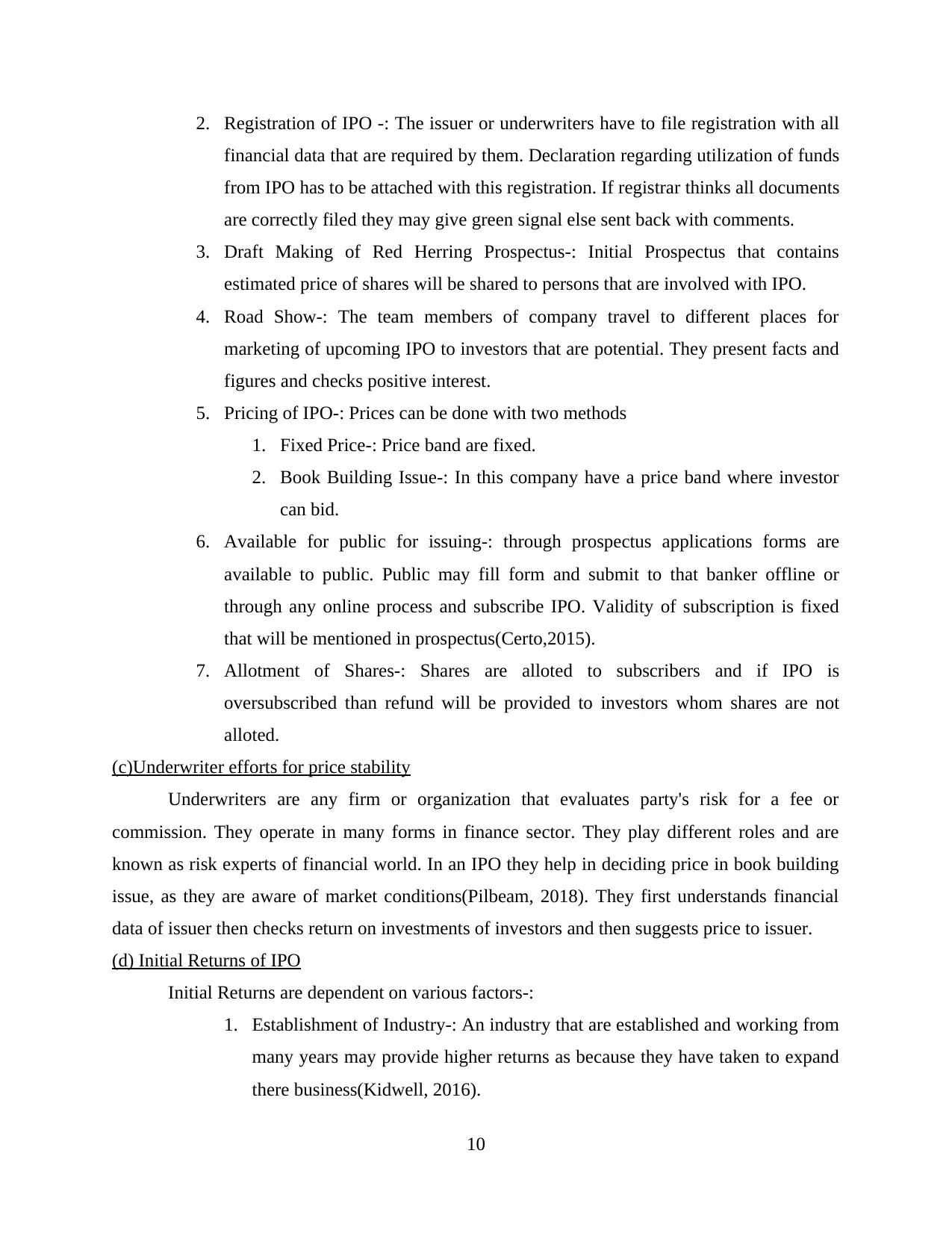
2. Registration of IPO -: The issuer or underwriters have to file registration with all
financial data that are required by them. Declaration regarding utilization of funds
from IPO has to be attached with this registration. If registrar thinks all documents
are correctly filed they may give green signal else sent back with comments.
3. Draft Making of Red Herring Prospectus-: Initial Prospectus that contains
estimated price of shares will be shared to persons that are involved with IPO.
4. Road Show-: The team members of company travel to different places for
marketing of upcoming IPO to investors that are potential. They present facts and
figures and checks positive interest.
5. Pricing of IPO-: Prices can be done with two methods
1. Fixed Price-: Price band are fixed.
2. Book Building Issue-: In this company have a price band where investor
can bid.
6. Available for public for issuing-: through prospectus applications forms are
available to public. Public may fill form and submit to that banker offline or
through any online process and subscribe IPO. Validity of subscription is fixed
that will be mentioned in prospectus(Certo,2015).
7. Allotment of Shares-: Shares are alloted to subscribers and if IPO is
oversubscribed than refund will be provided to investors whom shares are not
alloted.
(c)Underwriter efforts for price stability
Underwriters are any firm or organization that evaluates party's risk for a fee or
commission. They operate in many forms in finance sector. They play different roles and are
known as risk experts of financial world. In an IPO they help in deciding price in book building
issue, as they are aware of market conditions(Pilbeam, 2018). They first understands financial
data of issuer then checks return on investments of investors and then suggests price to issuer.
(d) Initial Returns of IPO
Initial Returns are dependent on various factors-:
1. Establishment of Industry-: An industry that are established and working from
many years may provide higher returns as because they have taken to expand
there business(Kidwell, 2016).
10
financial data that are required by them. Declaration regarding utilization of funds
from IPO has to be attached with this registration. If registrar thinks all documents
are correctly filed they may give green signal else sent back with comments.
3. Draft Making of Red Herring Prospectus-: Initial Prospectus that contains
estimated price of shares will be shared to persons that are involved with IPO.
4. Road Show-: The team members of company travel to different places for
marketing of upcoming IPO to investors that are potential. They present facts and
figures and checks positive interest.
5. Pricing of IPO-: Prices can be done with two methods
1. Fixed Price-: Price band are fixed.
2. Book Building Issue-: In this company have a price band where investor
can bid.
6. Available for public for issuing-: through prospectus applications forms are
available to public. Public may fill form and submit to that banker offline or
through any online process and subscribe IPO. Validity of subscription is fixed
that will be mentioned in prospectus(Certo,2015).
7. Allotment of Shares-: Shares are alloted to subscribers and if IPO is
oversubscribed than refund will be provided to investors whom shares are not
alloted.
(c)Underwriter efforts for price stability
Underwriters are any firm or organization that evaluates party's risk for a fee or
commission. They operate in many forms in finance sector. They play different roles and are
known as risk experts of financial world. In an IPO they help in deciding price in book building
issue, as they are aware of market conditions(Pilbeam, 2018). They first understands financial
data of issuer then checks return on investments of investors and then suggests price to issuer.
(d) Initial Returns of IPO
Initial Returns are dependent on various factors-:
1. Establishment of Industry-: An industry that are established and working from
many years may provide higher returns as because they have taken to expand
there business(Kidwell, 2016).
10
⊘ This is a preview!⊘
Do you want full access?
Subscribe today to unlock all pages.

Trusted by 1+ million students worldwide
1 out of 15
Related Documents
Your All-in-One AI-Powered Toolkit for Academic Success.
+13062052269
info@desklib.com
Available 24*7 on WhatsApp / Email
![[object Object]](/_next/static/media/star-bottom.7253800d.svg)
Unlock your academic potential
Copyright © 2020–2025 A2Z Services. All Rights Reserved. Developed and managed by ZUCOL.





